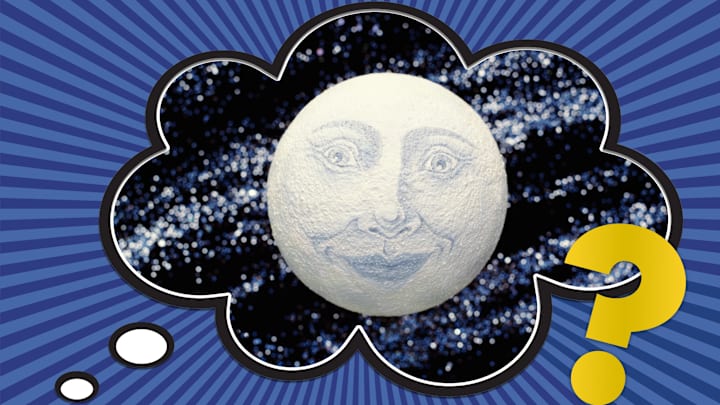Have you ever looked up at the moon and thought that you saw a face peering back at you? If so, you aren’t alone. The face you’re seeing is known as the Man in the Moon. People have been observing this lunar phenomenon—which is seen as different figures by cultures around the world—for hundreds (if not thousands) of years. Although there are mythological stories that seek to explain the figure’s presence on the surface of the moon, there’s also a perfectly scientific explanation.
The Man (in the Moon), the Myth, the Legend
Stories about the Man in the Moon date back to at least the 12th century, with theologian and writer Alexander Neckam penning a Latin verse about the figure. In English, it reads:
“See the rustic in the Moon,
How his bundle weighs him down;
Thus his sticks the truth reveal,
It never profits man to steal.”
In some other early versions of the myth, the Man in the Moon’s crime wasn’t theft, but instead working—by collecting sticks—on the Sabbath. On a 1335 seal, the lunar prisoner is kept company by a dog, and this canine addition to the legend eventually made its way into Shakespeare’s The Tempest. In Dante’s Inferno, written at the start of the 14th century, the man imprisoned on the moon is said to be Cain; he can be seen holding a bundle of thorns as punishment for murdering Abel. Over time, the moon man’s criminal past was forgotten and he instead developed a liking for alcohol, with a rhyme from the mid-1600s declaring: “Our man in the Moon drinks Claret, / With Powder béef turnep and Carret.” An early 19th-century nursery rhyme then put a non-boozy spin on the myth:
“The man in the moon
Came tumbling down,
And ask’d his way to Norwich.
He went by the south,
And burnt his mouth,
With supping cold pease porridge.”
The ever-changing lunar legend also plays an important part in the history of filmmaking, with the most iconic shot from Georges Méliès’s innovative 1902 short film A Trip to the Moon showing a rocket hitting the Man in the Moon’s eye.
The Many Faces of the Moon
People throughout history have seen more than just a man in the moon. In Scandinavian countries, its dark shapes are said to be a boy and girl called “Hjuki and Bila”—the Scandinavian version of Jack and Jill—whose names are respectively derived from the words for “increase” and “dissolve” and are linked to the waxing and waning of the moon. In Polynesian cultures, where the view of the moon is upside down compared to the Northern Hemisphere, the folk tales are about a woman in the moon. According to Māori mythology, a woman called Rona tripped in the dark while collecting water in a gourd and cursed the moon. Not appreciating the slight, the moon grabbed Rona and, despite her best efforts to hold onto a tree, she wound up trapped on the satellite (along with her gourd and the tree). In the Hawaiian version, a woman called Hina chose to live on the moon after tiring of life on Earth.
There are also many cultures that see animals on the moon. In Peruvian folklore, a fox climbed a rope to the moon. In America’s Pacific Northwest, a Salish story is told of a wolf falling in love with a distrustful toad, which hopped away and landed on the moon.

But the animal that crops—or rather, hops—up most often is the rabbit. In China, the Moon Rabbit, a.k.a. the Jade Rabbit, is the friend of the moon goddess Chang’e and uses a mortar and pestle to grind the elixir of life. In Korea, the lunar bunny is pounding the ingredients for rice cakes; in Japan it’s mochi. In both the Korean and Japanese versions, the rabbit offered itself as food to a hungry man who then revealed himself to be a celestial being and celebrated the animal by putting it on the moon. The Aztecs also had a similar story, with the self-sacrificing bunny being put on the moon by the god Quetzalcóatl. And in Canada, a Cree tale sees a rabbit riding a crane to the moon.
The Science Behind the Myth
The scientific explanation behind so many people seeing a face or figure in the moon is pareidolia, the human ability to ascribe meaning to random shapes and patterns. The human brain is particularly skilled at spotting faces, and sometimes the fusiform gyrus—the part of the brain responsible for facial recognition—is a little too eager. Pareidolia is why people see the Virgin Mary on a grilled cheese sandwich and Elvis Presley on a rock.
When looking at the moon, the human brain often identifies a face in the surface’s darker patches, known as maria or seas (early astronomers mistakenly thought these areas were filled with water). The maria are massive craters that, around 1–4 billion years ago, filled with lava that then hardened. The lava is less reflective than the rock that makes up the rest of the lunar surface. For people in the Northern Hemisphere, it’s the Seas of Serenity and Rain that look like eyes, the Seas of Islands and Vapours that form a nose, and the Sea of Clouds that becomes a mouth.
Discover More Stories About Folklore:
